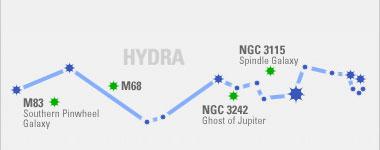
Don't let the scale of the diagram above fool you: Hydra is the largest constellation, and covers some 90° of sky. At this time of year, from mid-northern latitudes, it lies along the southern horizon at midnight.
To start, M83 is an impressive barred spiral galaxy that, from our vantage point in space, lies almost face-on. Even small scopes should pick up its obvious structure.
M68 is a nice globular cluster, 33,000 lightyears away. It's visible in binoculars but a telescope brings out the individual suns.
NGC 3242, the Ghost of Jupiter, is one of the finest planetary nebulae in the sky. It's a full magnitude brighter than the more famous Ring Nebula (M57) in Lyra. A small telescope reveals a pale blue disc with diffuse edges and the prominent 11th magnitude star. Due to its high surface brightness, this target takes high magnification quite well: try 200x or 250x to see the football-shaped interior and faint shell.
NGC 3115, the Spindle Galaxy, is actually in Sextans. In contrast to M83, this galaxy is seen almost edge on. It's a lenticular galaxy, meaning it's a disc galaxy with very little spiral structure.
April 2006
